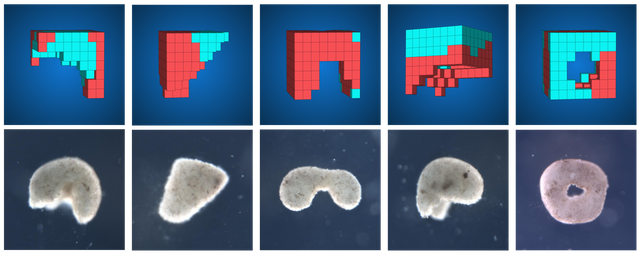Xenobot; Breakthrough on the First Living Robot
I have always known about cloning and cyborgs but in January 2020, scientist made a major breakthrough with the Xenobot. A robot not made from metals, plastic or wiring but mainly of living cells gotten. The 650 – 750 microns in diameter robot (about the size of a grain of salt) is made from stem cells gotten from frogs (stem cells are unspecialized cells that develop into different cell types). The xenobot is a self-healing robot that can move around, carry payloads, swim and survive without external introduction of food for about a week as they com preloaded with lipid and protein deposits which serves as food. The Xenobot can't reproduce or evolve.

The name xenobot was coined after an African frog Xenopus laevis where they got the stem cells. This robots are neither traditional robots like is always seen nor known species of animals, they are cells from frog embryos that are turned into living machine are programmed to work as they wish. The Xenobot is able to transport medicine around the body of patients and clean up pollution from ocean. In other to get this living robot, the researchers
These are novel living machines – Joshua Bongard
Computer scientists from the University of Vermont used deep green supercomputer cluster in configure the cells to work as a robot. The robot utilizes skin cells to bond structures and pulsing muscle cells for movement. Biologist from the center for regenerative and development biology at Tufts University got cells from frog embryo and incubated them and Douglas Blackiston a microsurgeon crafted the skin and heart cells into the designs gotten from the supercomputer.
There's no genetic engineering here, so we're not tinkering with viruses or the DNA of organisms. If you zoom in on a xenobot down to the level of an individual cell, you're looking at a normal frog cell - Douglas
The xenobots are biodegradable cells that dies seven days after they are done with their jobs. They become dead skin cells. The robots can self-heal themselves even when they are cut in halves.
Having a robot that could go to places where traditional robots can't go was the main motivation of the innovation. A xenobot could be used to administer medications to a specific target in the human body also it can be used to get microplastics in water bodies, clean up radioactive waste, and scrape plaques in arteries.
Since a supercomputer which is an AI was used to design the Xenobot programming, doubts about the use of AI to design weaponized CDOs could arise. In response to this, the scientists said it was possible theoretical but at the moment, it is difficult to see how AI could create harmful organisms and he further said that unlike an AI, a talented biologist with bad intentions could create one.
You can read more about the Xenobot here
Solid read. Resteemed and upvoted already @eni-ola
@tipu curate
Congratulations @eni-ola! You have completed the following achievement on the Steem blockchain and have been rewarded with new badge(s) :
You can view your badges on your Steem Board and compare to others on the Steem Ranking
If you no longer want to receive notifications, reply to this comment with the word
STOPDo not miss the last post from @steemitboard:
Vote for @Steemitboard as a witness to get one more award and increased upvotes!
This is really interesting read and a very cool scientific development. There could be so many useful applications of this. Your last paragraph reminded me though that all new technology can be abused by those wanting to turn something positive into something negative. Regulation will be needed as this technology is developed further.
Regulations are already being worked upon for the use of artificial intelligence, robotics and other new technological innovations.
I wonder what a robot about a grain of salt is capable of doing. Moreover, I still can't see why the Xenobot is termed "living" when it is incapable of reproduction and growth. Anyway, thanks for sharing this great work. Cheers!
The salt like robot is capable of causing lots of havoc in the hands of the wrong person. Something as small as that can go into the bloodstream of a human and deposit toxic substances if used wrongly.
It is termed living because it is made up of living cells and can feed. The robot might not be able to reproduce on its own but can multiply when splitted since it heals.
Thanks for the clarifications, Enny. I find it useful.
To a certain extent, it reminds me of the idea of biological support devices, which instead of electronic components, are designed with organic cells, perhaps it is very risky to say that they are "alive", but at least they are made of biological cells that are They usually consider part of living organisms.
The topic of creating robots from organic cells is interesting, it reminds me of the idea of biological computers, which I read instead of electronic components, are designed with organic cells, this kind of creations has the interesting quality of introducing a high computing power, but also a greater chance of random response to complex stimuli.
That's really true @pedrobrito, hopefully with time, there will be other ways to curb the effect of undeserved response.
The innovation looks exciting and beautiful, I think the only fear is what wicked programmers could do with the system.
Absolutely, we can only hope that it doesn't get into the wrong hands.
A great achievement for humanity, because with their help we can prevent and cure diseases, having an army of xenobots to cure cancer, perform a neurosurgery, cure chronic ailments, etc.
No doubt a beautiful breakthrough of the house was. Thanks for sharing.